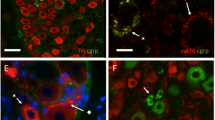Summary
Fifteen days after duct ligation, the wet weight of the rat submaxillary gland was reduced to 40% of the contralateral control. Under these experimental conditions, the noradrenaline (NA) content expressed as μg/g was 1.2±0.1 in the control glands and 1.9±0.2 in the atrophied glands.
The accumulation of 3H-NA in the tissue expressed as μCi/gland, did not differ when the atrophied glands were compared with the corresponding controls. Consequently, the uptake and retention of 3H-NA was not modified by the atrophy of the secretory cells of the gland.
The spontaneous efflux of radioactivity from normal and atrophied submaxillary glands prelabelled with 3H-NA was similar. The analysis of the metabolic pattern in both experimental groups revealed that in the spontaneous outflow and also during potassium-induced depolarization, the formation of the O-methylated metabolite, 3H-normetanephrine (NMN) was reduced by more than 50% in the atrophied glands. During depolarization induced by K+, a 2-fold increase in the outflow of the deaminated glycol 3H-3,4-dihydroxyphenylglycol (DOPEG) was observed.
The effect of phentolamine on the release of radioactivity induced by 60 mM K+ in normal and in atrophied submaxillary gland slices prelabelled with 3H-NA was also investigated. In both experimental groups, the fractional release of total radioactivity induced by K+ was similar. Phentolamine, 3.1 μM, produced a 3-fold increase in the fractional release of radioactivity both in the control and the atrophied glands. These results indicate that the increase of K+-induced release of 3H-NA induced by phentolamine was independent of the presence or absence of the postsynaptic structures. It is concluded that phentolamine increases transmitter release by blocking alpha-adrenoceptors located in the noradrenergic nerve endings of the rat submaxillary gland.
Similar content being viewed by others
References
Andén, N. E., Norberg, K. A., Olson, L.: The adrenergic nerves of rat salivary glands after excretory duct ligation. Acta Physiol. Scand. 66, 501–506 (1966)
Arbilla, S., Langer, S. Z.: Morphine and beta-endorphin inhibit noradrenaline release from the cerebral cortex but fail to reduce dopamine release from the rat striatum Nature 271, 559–561 (1978)
Bhaskar, A. N., Bolden, T. E., Weinmann, J. P.: Experimental obstructive adenitis in the mouse. J. Dent. Res. 35, 852–862 (1956)
Dubocovich, M. L., Langer, S. Z.: Influence of the frequency of nerve stimulation on the metabolism of 3H-norepinephrine released from the perfused cat spleen: differences observed during and after the period of stimulation. J. Pharmacol. Exp. Ther. 198, 83–101 (1976)
Farah, M. B., Adler-Graschinsky, E., Langer, S. Z.: Physiological significance of the initial step in the catabolism of noradrenaline in the central nervous system of the rat. Naunyn-Schmiedeberg's Arch. Pharmacol. 297, 119–131 (1977)
Gracfe, K. H., Stefano, F. J. E., Langer, S. Z.: Preferential metabolism of (−) 3H-norepinephrine through the deaminated glycol in the rat vas deferens. Biochem. Pharmacol. 22, 1147–1160 (1973)
Graefe, K. H., Stefano, F. J. E., Langer, S. Z.: Metabolism of 3H-(−) and 3H-(±) noradrenaline during uptake into and efflux from the isolated rat vas deferens. Naunyn-Schmiedeberg's Arch. Pharmacol. 229, 225–238 (1977)
Jonason, J.: Metabolism of dopamine and noradrenaline in normal, atrophied and postganglionically sympathectomized rat salivary glands in vitro. Acta Physiol. Scand. 76, 299–311 (1969)
Junqueira, L. C.: Cytological, cytochemical and biochemical observations on secretory and resting salivary glands. Exp. Cell. Res. 2, 327–338 (1951)
Junqueira, L. C., Ravinovich, M.: Reversibility of the phenomena induced by excretory duct ligature in the rat submaxillary gland. Tex. Rep. Biol. Med. 12, 95–97 (1954)
Langer, S. Z.: Presynaptic regulation of catecholamine release. Biochem. Pharmacol. 23, 1793–1800 (1974a)
Langer, S. Z.: Selective metabolic pathways for noradrenaline in the peripheral and in the central nervous system. Med. Biol. 52, 372–383 (1974b)
Langer, S. Z.: Presynaptic receptors and their role in the regulation of transmitter release. Br. J. Pharmacol. 60, 481–497 (1977)
Langer, S. Z., Enero, M. A.: The potentiation of responses to adrenergic nerve stimulation in the presence of cocaine: its relationship to the metabolic fate of released norepinephrine. J. Pharmacol. Exp. Ther. 191, 431–443 (1974)
Langer, S. Z., Farah, M. B., Luchelli-Fortis, M. A., Adler-Graschinsky, E., Filinger, E.: Mctabolism of endogenous noradrenaline. Proceedings of the Sixth International Congress of Pharmacology, Helsinki, Finland, vol. 2 on Neurotransmission, pp. 17–31 (1975)
Laverty, R., Taylor, K. M.: The fluorometric assay of catecholamines and related compounds. Anal. Biochem. 22, 269–279 (1968)
Luchelli-Fortis, M. A., Langer, S. Z.: Selective inhibition by hydrocortisone of 3H-normetanephrine formation during 3H-transmitter release elicited by nerve stimulation in the isolated nerve-muscle preparation of the cat nictitating membrane. Naunyn-Schmiedeberg's Arch. Pharmacol. 287, 261–276 (1975)
Ohlin, P., Perec, C.: Secretory responses and choline acetylase of the rat's submaxillary gland after duct ligation. Experientia 23, 248 (1967)
Pelayo, F., Dubocovich, M. L., Langer, S. Z.: Regulation of noradrenaline release in the rat pineal through a negative feedback mechanism mediated by presynaptic alpha-adrenoceptors. Eur. J. Pharmacol. 45, 317–318 (1977)
Snedecor, G. W., Cochran, W. G.: Statistical methods, 6th Ed. Ames: The Iowa State University Press 1969
Standish, S. M., Shafer, W. G.: Serial histologic effects of rat submaxillary and sublingual salivary gland duct and blood vessel ligation. J. Dent. Res. 36, 866–879 (1957)
Starke, K.: Regulation of noradrenaline release by presynaptic receptor systems. Rev. Physiol. Biochem. Pharmacol. 77, 1–124 (1977)
Stefano, F. J. E., Perec, C. J., Tumilasci, O. R.: Changes in neuronal uptake and metabolism of, and sensitivity to, norepinephrine during the degeneration secretion in the rat submaxillary gland. J. Pharmacol. Exp. Ther. 191, 403–417 (1974)
Author information
Authors and Affiliations
Rights and permissions
About this article
Cite this article
Filinger, E.J., Langer, S.Z., Perec, C.J. et al. Evidence for the presynaptic location of the alpha-adrenoceptors which regulate noradrenaline release in the rat submaxillary gland. Naunyn-Schmiedeberg's Arch. Pharmacol. 304, 21–26 (1978). https://doi.org/10.1007/BF00501373
Received:
Accepted:
Issue Date:
DOI: https://doi.org/10.1007/BF00501373




